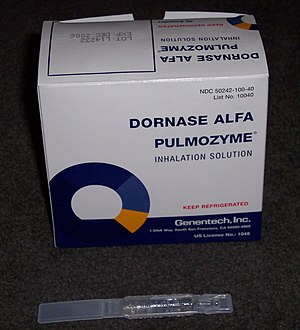Dornase alfa
 | |
| Names | |
|---|---|
| Trade names | Pulmozyme |
| Clinical data | |
| Pregnancy category |
|
| Routes of use | Inhalation |
| External links | |
| AHFS/Drugs.com | Monograph |
| MedlinePlus | a694002 |
| Legal | |
| Legal status |
|
| Chemical and physical data | |
| Formula | C1321H1999N339O396S9 |
| Molar mass | 29253.9 g·mol−1 |
Dornase alfa, sold under the brand name Pulmozyme, is a medication used to treat cystic fibrosis.[1] It is used to decrease the thickness of mucus and thus make it easier to cough out.[1] It is used by breathing it in.[1]
Common side effects include change in voice, rash, throat inflammation, chest pain, runny nose, fever, and shortness of breath.[2] While there is no evidence of harm in pregnancy, such use has not been well studied.[3] It is a recombinant human deoxyribonuclease I (rhDNase), an enzyme which breaks up DNA outside the cell.[4]
Dornase alfa was approved for medical use in the United States in 1993.[1] In the United Kingdom a month of medication costs the NHS about £500 as of 2021.[4] In the United States this amount costs about 3,400 USD.[5]
Medical uses
Cystic fibrosis
Dornase alfa is used for cystic fibrosis.
It is an orphan drug.[6]
Dosage
It is generally used at a dose of 2.5 mg once per day; though some may use twice per day.[2]
Contraindications
- Hypersensitivity to dornase alfa
- Hypersensitivity to Chinese hamster ovary cell products
Society and culture
Economy
Dornase alpha 1000 units (1 mg/ml)2.5ml (2500units) = £18.52 (GBP)
Manufacture
This protein therapeutic agent is produced in Chinese hamster ovary cells.
Research
Dornase alfa may improve lung function in non-cystic fibrosis pre-term infants atelectasis where other therapies have failed.[7][8]
In studies conducted, Dornase alfa has been thought to help resolve mucus secretion in CoViD-19 patients as well as in the treatment of cystic fibrosis, but since it is taken with nebulizer in general use and there is a possibility of aerosolization of the virus, it is not preferred in most medical centers to avoid secondary infections.[9]
References
- ↑ 1.0 1.1 1.2 1.3 "Dornase Alfa Monograph for Professionals". Drugs.com. Archived from the original on 11 August 2020. Retrieved 27 December 2021.
- ↑ 2.0 2.1 "DailyMed - PULMOZYME- dornase alfa solution". dailymed.nlm.nih.gov. Archived from the original on 24 March 2021. Retrieved 27 December 2021.
- ↑ "Dornase alfa (Pulmozyme) Use During Pregnancy". Drugs.com. Archived from the original on 24 October 2020. Retrieved 27 December 2021.
- ↑ 4.0 4.1 BNF 81: March-September 2021. BMJ Group and the Pharmaceutical Press. 2021. p. 309. ISBN 978-0857114105.
- ↑ "Dornase Alfa Prices, Coupons & Savings Tips - GoodRx". GoodRx. Retrieved 27 December 2021.
- ↑ Collier, Joe (1 September 1995). "Dornase-alfa and orphan drugs". The Lancet. 346 (8975): 633. doi:10.1016/S0140-6736(95)91460-9. PMID 7651014. S2CID 5456247.
- ↑ Erdeve O, Uras N, Atasay B, Arsan S (2007). "Efficacy and safety of nebulized recombinant human DNase as rescue treatment for persistent atelectasis in newborns: case-series". Croat Med J. 48 (2): 234–9. PMC 2080511. PMID 17436388.
- ↑ Hendriks T, de Hoog M, Lequin MH, Devos AS, Merkus PJ (2005). "DNase and atelectasis in non-cystic fibrosis pediatric patients". Crit Care. 9 (4): R351-6. doi:10.1186/cc3544. PMC 1269442. PMID 16137347.
- ↑ Barnes, Betsy J.; Adrover, Jose M.; Baxter-Stoltzfus, Amelia; Borczuk, Alain; Cools-Lartigue, Jonathan; Crawford, James M.; Daßler-Plenker, Juliane; Guerci, Philippe; Huynh, Caroline; Knight, Jason S.; Loda, Massimo (2020-06-01). "Targeting potential drivers of COVID-19: Neutrophil extracellular traps". Journal of Experimental Medicine. 217 (6). doi:10.1084/jem.20200652. ISSN 0022-1007. PMC 7161085. PMID 32302401.
External links
| Identifiers: |
|
|---|
- Pages using duplicate arguments in template calls
- Chem-molar-mass both hardcoded and calculated
- Chemical articles with unknown parameter in Infobox drug
- Chemical articles without CAS registry number
- Articles without EBI source
- Chemical pages without ChemSpiderID
- Chemical pages without DrugBank identifier
- Articles without KEGG source
- Articles without InChI source
- Articles without UNII source
- Drugs missing an ATC code
- Drugboxes which contain changes to verified fields
- Drugboxes which contain changes to watched fields
- Articles with changed CASNo identifier
- Chemicals that do not have a ChemSpider ID assigned
- Drugs acting on the respiratory system
- Recombinant proteins
- Hoffmann-La Roche brands
- Genentech brands
- RTT